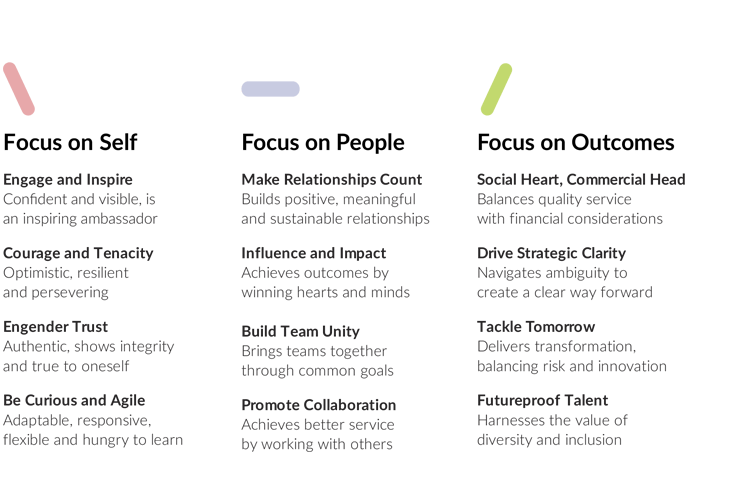The below article featured in The MJ magazine.
Covid-19 has led to a seismic shift in society. In responding to often conflicting challenges and opportunities, local government leadership has been physically, emotionally and intellectually stretched to an extent few would have imagined pre-pandemic. The question now is whether this period has led to a fundamental shift in what good leadership looks like as the sector heads towards recovery.
We have found this a fascinating period in which to analyse the data output from our GatenbySanderson leadership model, Altitude, the only model to benchmark behavioural excellence for leaders working across the public and local government Sectors. The Altitude model consists of 12 behaviours falling into three clusters; Focus on Self, Focus on People and Focus on Outcomes. In a period when people and outcomes have been front and centre in successfully managing crisis, we were interested to determine whether leadership skills were evolving to reflect organisational and community demands.
Assessment data, for over 3,500 leaders, has been mapped to these behaviours giving us a benchmark to compare leader capability in local government against the broader Public Sector. Any variance generates a Net Leadership Capability score that is reported as a ‘strength’ or a ‘risk’.

While all 12 Altitude behaviours are key to leadership success, we were particularly interested in those most relevant to immediate challenges. Data comparison pre and post the first lockdown suggests some clear shifts in leadership behaviours and style as a direct result of the pandemic. These shifts present both challenges and opportunities for the sector.
Competencies which suggest an ability to maximise social value have significantly increased in terms of leadership potential. Response to the pandemic has engendered a powerful sense of common purpose with teams and organisation pulling together to tackle a common foe. It’s not an exaggeration to suggest that the pandemic has brought out the best in local authorities, and this is strongly backed up by the data. ‘Social Heart/Commercial Head’ has increased significantly in terms of leadership potential during the pandemic, as has the ability of leaders to ‘Engender Trust’.
Pre-pandemic, leaders’ potential to ‘Engender Trust’ and ‘Make Relationships Count’ in local government were significantly lower than the rest of the public sector; both, alongside ‘Social Heart, Commercial Head’, have increased during and post pandemic. Numerous anecdotes supporting this shift presents of a style of leadership characterised by taking tough decisions for the common good, underpinned by a powerful sense of purpose. Yet whilst the trust has built, the data also suggests that the ability to influence and inspire has declined in local government leaders in the same period. While this is not surprising, given the relentless focus on delivery, leaders who can engage and inspire will find themselves in even greater demand as local government moves towards recovery. If emphasis during the pandemic has been on saving lives and keeping the community safe and functioning, the focus for recovery needs to be on crafting a compelling vision for the future of local government and inspiring often exhausted teams to deliver that vision.
The continual challenge of ‘having to do more with less’ combined with a lack of development investment has created what we call ‘the paradox of local government leadership development’. When leaders are under great pressure to work harder and longer with ever changing demands on their time and energy, it’s no surprise that their own personal development takes a back seat. This hiatus in leadership growth anchors skills and capability to the past rather than accelerating them to a new future.
Perhaps unsurprisingly, the biggest downward data shift was on ‘Strategic Clarity’; our data suggests this is a significant risk for LG Leaders. The unprecedented nature of the pandemic has led to reactive management with a constantly changing pattern of competing demands and counter-demands. This style of leadership will have been uncomfortable for many, but those who maintained strategic purpose and can quickly navigate the organisation back to its future strategy will succeed faster.
Undoubtedly, the pandemic has spun a complex web of challenges and demands, and our data indicates that local authority leaders have responded with a relentless focus on the task in hand with their teams trusting them to act in the best interests of society. Local authority leaders will increasingly need to adapt their leadership style, to bring strategic clarity, and to engage and inspire their teams towards a fundamentally different world. Given the changes to local government services which have emerged, there are huge opportunities for local authorities and leaders who are able to do so.
Whilst clearly a human tragedy of unimaginable proportions, the pandemic has driven positive change and brought momentum to new service delivery and re-energised a powerful sense of common purpose. To maximise these benefits and emerge stronger, local government leadership must work proactively, and at speed, to retain these positives as business as usual returns. Likewise, leaders must leave aside task orientation behaviours to better inspire, influence and provide long-term strategic clarity. Leaders in the sector must work to rebuild these skills as they steer their organisations through recovery and the choppy waters beyond.
Seb Lowe, Partner, Executive Search and Liaquat Lal, Partner, Leadership & Talent Consultancy are members of the GatenbySanderson Local Government Practice. Please contact us if you would like further insight into our data for your leadership development and executive search and recruitment.
